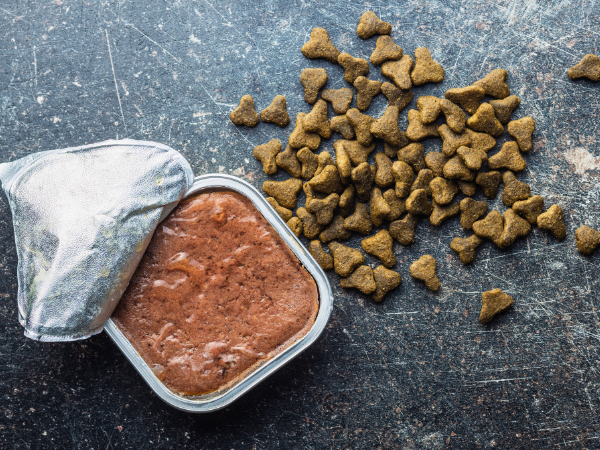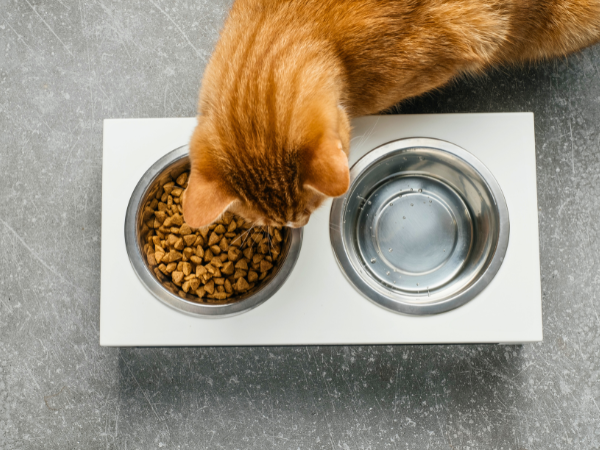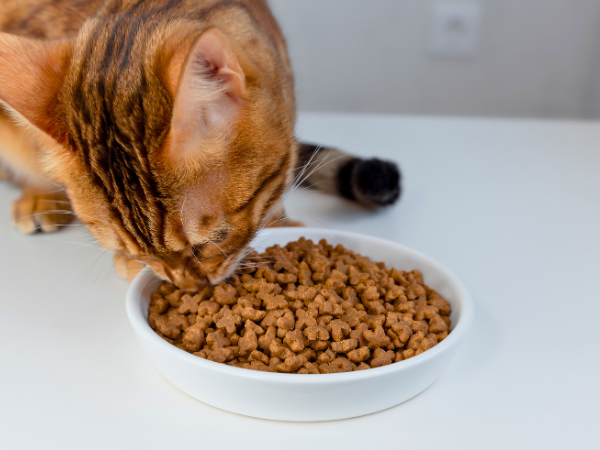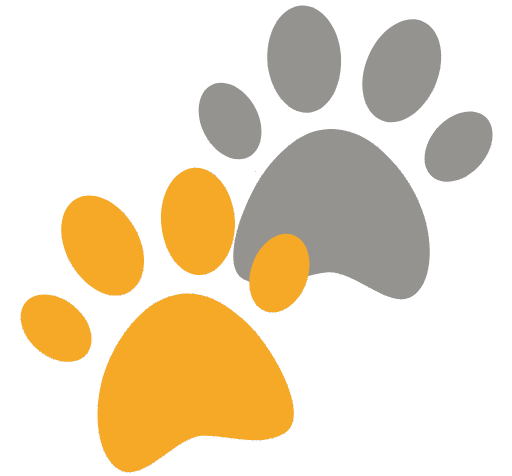Feeding your dog cat food might seem harmless at first. After all, they share a home and sometimes their food bowls look alike.
However, cat food is designed specifically for cats and contains higher levels of protein and fat. This difference can cause various health problems for dogs.
Can Dogs Eat Cat Food?
While a small taste won’t harm, regular consumption can lead to long-term health issues in dogs. Cat food is designed for cats, not dogs, and can cause serious health risks if eaten frequently.
Occasional Bites Vs. Regular Feeding
Occasional bites of cat food may not seem harmful. However, the impact of regular feeding can be significant. Dogs have different dietary needs than cats. Here’s a breakdown of the differences:
| Aspect | Dog Food | Cat Food |
|---|---|---|
| Protein Level | Moderate | High |
| Fat Content | Lower | Higher |
| Essential Nutrients | Tailored for dogs | Not suitable for dogs |
Regularly eating cat food can lead to:
- Obesity
- Pancreatitis
- Digestive problems
- Nutritional deficiencies
In summary, occasional bites won’t harm a dog, but consistent feeding can disrupt their health.
Why Cat Food Appeals To Dogs
Many dogs are drawn to cat food. This attraction is due to its higher fat and protein levels. These ingredients make cat food smell and taste irresistible to many dogs.
- Strong Aroma: Cat food has a stronger smell than dog food.
- Tasty Ingredients: Meat-based ingredients are often more palatable.
- Texture: Soft and chewy textures appeal to many dogs.
While the taste may tempt dogs, it does not provide the balanced nutrition they need. Dogs require a different set of nutrients to thrive.

Key Differences Between Dog And Cat Food
Cat food often contains higher levels of protein and fat compared to dog food. These differences can lead to health risks for dogs who eat cat food.
High Protein Content: Too Much For A Dog’s System
Cat food often contains 30–40% protein—far higher than the 18–25% typically needed by dogs. This excess protein can overwhelm a dog’s digestive system. Dogs are not designed to handle such high levels of protein. The impact can be serious:
- Kidney stress
- Dehydration
- Increased urination
- Potential weight gain
Too much protein can lead to long-term health issues. Owners should monitor what their dogs eat closely.
Excess Fat: Not Ideal For Canine Health
Cat food is formulated with more fat—up to 20%—to meet feline energy needs. This level of fat is not suitable for dogs. High-fat diets can lead to several health problems:
- Obesity
- Pancreatitis
- Digestive problems
Fat is essential for dogs, but only in moderation. High levels can lead to serious health risks that can be avoided.
Missing Nutrients: What Cat Food Lacks For Dogs
Dog diets need specific nutrients. Important ones include:
- Vitamin E
- Fiber
- Proper calcium/phosphorus balance
These nutrients are often missing in cat food. While cat food meets feline needs, it does not support canine health. A dog lacking in these nutrients may experience:
- Weak bones
- Skin problems
- Digestive issues
It’s vital to provide dogs with a balanced diet tailored for them. Feeding cat food can lead to nutrient deficiencies that affect overall health.

Risk #1 – Gastrointestinal Upset
One major concern is gastrointestinal upset. Dogs and cats have different dietary needs. Cat food is rich and high in protein and fat. This can upset a dog’s stomach.
Symptoms To Watch For After Ingesting Cat Food
After a dog eats cat food, you may notice several symptoms. These signs indicate gastrointestinal upset. Look for:
- Vomiting: Dogs may vomit shortly after eating.
- Diarrhea: Loose stools can occur as the body tries to expel the food.
- Flatulence: Increased gas production can lead to discomfort.
- Bloating: A swollen belly may indicate serious distress.
These symptoms can range from mild to severe. If your dog shows any of these signs, monitor them closely.
Why Dog Stomachs Can’t Handle Cat Formulas
Dogs have less tolerance for rich foods compared to cats. Cat food formulas contain higher levels of protein and fat. This is necessary for cats but not for dogs.
- Different Nutritional Needs: Dogs require a balanced diet with lower protein levels.
- Digestive Enzymes: Dogs have fewer enzymes to break down high-fat content.
- Gut Flora: Dogs have different gut bacteria that struggle with cat food.
This mismatch can lead to gastrointestinal issues. Dogs eating cat food may experience discomfort. It’s essential to keep dog and cat food separate.
Risk #2 – Obesity And Weight Gain
One major risk is obesity and weight gain. Dogs are not designed to digest cat food, which is richer in calories. This can cause dogs to gain weight quickly.
Caloric Density Of Cat Food Vs. Dog Food
Cat food is often more calorie-dense than dog food. The average caloric content is:
| Food Type | Calories per Cup |
|---|---|
| Cat Food | 400–500 kcal/cup |
| Dog Food | 300–350 kcal/cup |
This difference can lead to weight gain in dogs. When dogs eat cat food, they consume more calories than they need. This can happen quickly, especially if the dog enjoys the taste.
- Higher calorie intake
- Less physical activity
- Increased fat storage
Over time, this can result in overweight dogs. Owners may not notice the gradual weight gain until it is too late.
Long-term Weight-related Health Issues In Dogs
Excess weight increases the risk of several health issues in dogs. Common problems include:
- Arthritis
- Diabetes
- Heart conditions
These conditions can lead to a decrease in quality of life. Dogs may experience pain and discomfort. They may also have less energy and become less active.

Risk #3 – Pancreatitis From High Fat Content
One major risk is pancreatitis. This condition can arise due to the high fat content in cat food. Dogs’ digestive systems are not designed to handle such rich meals.
How Cat Food Triggers Pancreatitis In Dogs
High-fat meals can inflame the pancreas, especially in smaller or sensitive breeds. This can lead to pancreatitis, a painful condition. Here are some key points about how this happens:
- Cat food is designed for cats, not dogs.
- Dogs eating cat food can experience digestive distress.
- Fatty foods can cause the pancreas to overwork.
- Overworking the pancreas can lead to inflammation.
In severe cases, pancreatitis can become life-threatening. It is crucial to monitor your dog’s food intake. If your dog has eaten cat food, watch for signs of discomfort.
Signs Your Dog May Be Suffering An Episode
Recognizing the signs of pancreatitis in dogs is vital. Symptoms may vary but usually include:
- Loss of appetite
- Abdominal pain
- Lethargy
- Vomiting
Other signs can include:
- Diarrhea
- Fever
- Dehydration
Watch for loss of appetite, abdominal pain, lethargy, and vomiting. If you notice any of these symptoms, contact your veterinarian.
Risk #4 – Kidney And Liver Strain
One significant concern is the strain on their kidneys and liver. Cats require more protein in their diet than dogs do. When dogs consume cat food regularly, their bodies can struggle to process the excess protein.
Overload Of Protein And Organs At Risk
Dogs that eat cat food face an overload of protein. This is harmful because:
- Excess protein stresses kidneys and liver.
- Older dogs or those with pre-existing conditions are at higher risk.
- Protein overload can cause dehydration.
- Increased toxin buildup occurs in the body.
The kidneys filter waste and excess substances from the blood. A high-protein diet forces them to work harder. This can lead to:
| Organ | Effects of Protein Overload |
|---|---|
| Kidneys | Increased workload, potential damage, and failure. |
| Liver | Strain from processing too much protein, risk of liver disease. |
Chronic high-protein intake may cause organ damage. Dogs are not designed to handle the same levels of protein as cats.
How Continuous Exposure Affects Long-term Health
Long-term exposure to cat food can have lasting effects on a dog’s health. The excess protein leads to chronic conditions. Here are some potential issues:
- Kidney disease develops over time.
- Liver problems may arise from constant strain.
- Dehydration becomes a frequent issue.
Over time, the body builds up toxins due to inefficient processing. This can create a cycle of illness. Dogs may show signs of:
- Fatigue and lethargy.
- Loss of appetite.
- Weight loss or gain issues.
It is vital to monitor a dog’s diet closely. Regular vet check-ups can help identify problems early. Proper nutrition is key to maintaining health.
Risk #5 – Nutritional Deficiencies In Dogs
One major risk is nutritional deficiencies. Cat food does not provide the right nutrients dogs need. This can cause various health problems over time.
What Cat Food Doesn’t Provide For Canine Health
Cat food is formulated for cats, not dogs. Dogs require different nutrients for optimal health. Here are some key nutrients that cat food lacks:
- Proper Fiber: Dogs need fiber for digestion. Cat food typically has lower fiber content.
- Vitamin D3: This vitamin helps in calcium absorption. Cat food often lacks this vital nutrient for dogs.
- Balanced Omega-3s: Dogs require a specific balance of omega-3 fatty acids. Cat food does not provide this balance.
These deficiencies can lead to digestive issues and poor overall health.
Why Dog-specific Nutrients Matter
Dogs thrive on a diet rich in specific nutrients. They require a unique balance of amino acids, vitamins, and minerals. Cat food does not meet these needs.
- Amino Acids: Dogs need certain amino acids for muscle growth. Cat food does not provide the right balance.
- Vitamins: Dogs need vitamins like A, C, and E for immune support. These are often found in dog food but lacking in cat food.
- Minerals: Dogs need minerals like calcium and phosphorus for strong bones. Cat food may not have the right amounts.
Feeding dogs cat food can lead to serious long-term health issues. It is crucial to provide them with a balanced diet designed for their specific needs.


